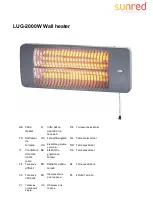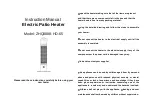
4
EN
– It is prohibited to use products containing
chlorine on and in the appliance.
– Keep the cowl for the exhaust duct and
combustion air infeed free of contamination
(slush, ice, leaves etc.) at all times.
– Danger from hot surfaces and exhaust gas.
Do not touch the area around the wall cowl
and do not lean any objects against the wall
cowl or the vehicle.
Obligations of the operator / vehicle owner
– The operator is responsible for the water
with which the Combi boiler is filled, and for
its quality.
– Maximum feed water pressure, see
“Technical data” on page 10.
– The vehicle owner is responsible for correct
operation of the appliance.
– The Combi has no built-in frost protection
function. Freezing water can cause serious
damage to the appliance. The operator is
responsible for protecting the Combi
against frost damage, e.g. by using the
Truma FrostControl. In appliances without
FrostControl (e.g. the UK version) or when
the appliance is not in operation, it is essen-
tial to drain off the water content if there is a
risk of frost. No claims may be made under
the warranty for damage caused by frost.
– The installer or vehicle owner must affix the
supplied yellow sticker with the warning
information in a location in the vehicle
where it is clearly visible to all users (e.g.
the wardrobe door). Missing stickers can be
requested from Truma.
– Liquid gas systems must comply with the
technical and administrative regulations of
the respective country of use (e.g. EN 1949
for vehicles in Europe). The national legisla-
tion and regulations (e.g. DVGW Work Sheet
G 607 for vehicles in Germany) must be
observed.
– The vehicle owner must arrange for the in-
spection of the gas system by a liquid gas ex-
pert (DVFG, TÜV, DEKRA) in accordance with
the relevant national regulations (in Germany
every 2 years). The test must be confirmed on
the respective test certificate (G 607).
– Pressure regulating devices and hoses must
be replaced with new ones no more than
10 years after their date of manufacture
(every 8 years if used commercially).
– Inspect hose lines regularly and have them
replaced if they are broken.
Safe operation
– The exhaust cowl must not be blocked. It is
forbidden to fit cowl covers.
– The appliance may only be used if the con-
nection cover for cable connections is fitted.
– The use of upright gas cylinders from which
gas is
taken in the gas phase
is mandatory
for the operation of gas pressure regulation
systems, gas equipment and gas systems.
Gas cylinders from which gas is taken in the
liquid phase (e.g. for fork lifts) must not be
used, since they would result in damage to
the gas system.
– The operating pressure of the gas supply
(30 mbar) and of the appliance (see type
plate) must be the same.
– In Germany, only pressure regulating equip-
ment that complies with DIN EN 16129 (in
vehicles) with a fixed output pressure of
30 mbar may be used for the gas system.
The flow rate of the pressure regulating
equipment must correspond to at least the
maximum consumption of all appliances in-
stalled by the system manufacturer.
– We recommend the Truma MonoControl CS
gas pressure regulator for vehicles, and also
the DuoControl CS gas pressure regulator for
the two-cylinder gas system.
– At temperatures of around 0 °C and below,
the gas pressure regulator or the changeo-
ver valve should be operated with the EisEx
regulator heater.
– Suitable hoses that meet national regulations
must always be used in the respective coun-
try for which the equipment is destined.
– During the initial start-up of a brand new
appliance, small quantities of fumes and a
slight odour may briefly occur. When the
appliance is started up after a particularly
long period of non-use, there may be some































